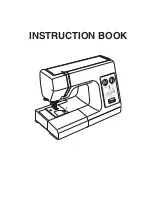
SEWING BASICS
— — — — — — — — — — — — — — — — — — — — — — — — — — — — — — — — — — — — — — — — — — — —
58
Setting the Stitch
This machine is preset with the default settings for the stitch width, stitch length, and upper thread tension
for each stitch. However, you can change any of the settings by pressing
in the screen, then
following the procedure described in this section.
Note
z
If the thread tension cannot be adjusted as desired, refer to “List of symptoms” (page 197).
z
Settings for some stitches cannot be changed. For details, refer to “Stitch Setting Chart” (page 70).
z
Stitch settings return to their defaults if they are changed, when the machine is turned off or a different
stitch is selected before the stitch setting is saved.
Adjusting the stitch width
The stitch width (zigzag width) can be adjusted to
make the stitch wider or narrower.
Each press of
makes the zigzag stitch narrower.
Each press of
makes the zigzag stitch wider.
Memo
z
Press
to return the setting to its default.
z
If the straight stitch (left needle position or triple
stretch stitch) was selected, changing the stitch
width changes the needle position. Increasing
the width moves the needle to the right;
reducing the width moves the needle to the left.
z
The sewing machine can be set so that the
stitch width can easily be changed with the
sewing speed controller. For details, refer to
“Satin stitching using the sewing speed
controller” (page 111).
z
means the setting cannot be adjusted.
CAUTION
●
After adjusting the stitch width, slowly
turn the handwheel toward you
(counterclockwise) and check that the
needle does not touch the presser foot. If
the needle hits the presser foot, the
needle may bend or break.
Summary of Contents for NV1250D
Page 2: ... ...
Page 6: ...4 ...
Page 50: ...GETTING READY 48 ...
Page 212: ...XE6389 1011 English 885 U01 Printed in China ...
















































